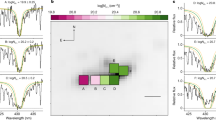Abstract
A new method based on a Reverse Monte Carlo [RMC] technique and aimed at the inverse problem in the analysis of interstellar (intergalactic) absorption lines is presented. The line formation process in chaotic media with a finite correlation length (l > 0) of the stochastic velocity field (mesoturbulence) is considered. This generalizes the standard assumption of completely uncorrelated bulk motions (l ≢ 0) in the microturbulent approximation which is used for the data analysis up-to-now. It is shown that the RMC method allows to estimate from an observed spectrum the proper physical parameters of the absorbing gas and simultaneously an appropriate structure of the velocity field parallel to the line-of-sight.
The application to the analysis of the H+D Lyα profile is demonstrated using Burles and Tytler [B&T] data for QSO 1009+2956 where the DI Lyα line is seen at za = 2.504.
The results obtained favor a low D/H ratio in this absorption system, although our upper limit for the hydrogen isotopic ratio of about 4.5 × 10-5 is slightly higher than that of B&T (D/H = 30 +0.6-0.5 × 10-5). We also show that the D/H and N(HI) values are, in general, correlated, i.e. the derived D-abundance may be badly dependent on the assumed hydrogen column density. The corresponding confidence regions for an arbitrary and a fixed stochastic velocity field distribution are calculated.
Similar content being viewed by others
References
Burles, S. and Tytler, D.: 1996, ‘Cosmological deuterium abundance and the baryon density of the Universe’, preprint, astro-ph 9603070 [B&T].
Levshakov, S.A. and Takahara, H.: 1996, ‘The effect of spatial correlations in a chaotic velocity field on the D/H measurements from QSO absorption spectra’, Monthly Notices Roy. Astron. Soc. 279, 651–660.
Levshakov, S.A. and Kegel, W.H.: 1997, ‘New aspects of absorption line formation in intervening turbulent clouds — I. General principles’, Monthly Notices Roy. Astron. Soc. 288, 787–801, [Paper I].
Levshakov, S.A., Kegel, W.H., and Mazets I.E.: 1997, ‘New aspects of absorption line formation in intervening turbulent clouds — II. Monte Carlo simulation of interstellar H+D Lyα absorption profiles’, Monthly Notices Roy. Astron. Soc. 288, 802–816, [Paper II].
Levshakov, S.A., Kegel, W.H. and Takahara F.: 1997, ‘New aspects of absorption line formation in intervening turbulent clouds — III. The inverse problem in the study of H+D profiles’, Monthly Notices Roy. Astron. Soc., submitted, [Paper III].
Metropolis, N. et al.: 1953, ‘Equation of state calculations by fast computing machines’, J. Chem. Phys. 21, 1087–1092.
Sarkar, S.: 1996, ‘Big bang nucleosynthesis and physics beyond the standard model’, Rep. Prog. Phys. 59, 1493–1609.
Walker, T.P. et al.: 1991, ‘Primordial nucleosynthesis redux’, Astrophys. J. 351, 51–69.
Author information
Authors and Affiliations
Rights and permissions
About this article
Cite this article
Levshakov, S.A., Kegel, W.H. & Takahara, F. A Reverse Monte Carlo Study of H+D Lyman Alpha Absorption from QSO Spectra. Space Science Reviews 84, 77–82 (1998). https://doi.org/10.1023/A:1005038427550
Issue Date:
DOI: https://doi.org/10.1023/A:1005038427550




